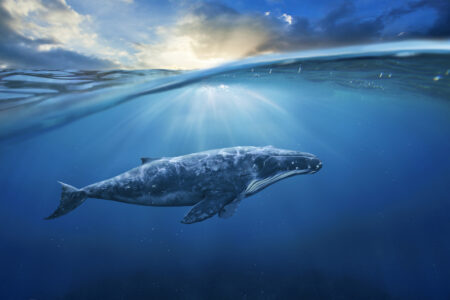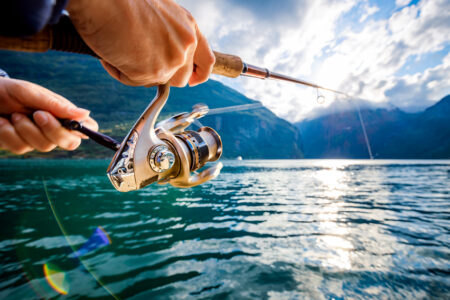NanoPlastic particles are smaller and deadlier than their counterpart, MicroPlastic. Being smaller, NanoPlastic particles are able to penetrate and corrupt living systems. Both are dangerous.
Consolidated Waste Systems brings you news of how they are currently corrupting our land, rivers, lakes, and our food supplies.
A Look Back: The basics, Our Atmosphere, and Ocean

Micro- and NanoPlastic Penetrates Our World, Our Rivers, and Lakes, and Then, Even the Food We Eat.
Up to this point, our Consolidated Waste Systems series on MicroPlastic particles has examined the problems that face us in our atmosphere and our oceans. This week, we examine the plastic invasion of our lakes, rivers, soil, and drinking water.
First, we introduce a new and dangerous character into our story, NanoPlastic. Actually, you met him last week, but only in passing.
NanoPlastic Particles Defined
Scientists define MicroPlastics as “plastic fragments less than 5 mm or about 0.2 inches in diameter. NanoPlastics are even smaller. NanoPlastic particles have a diameter less than 0.001 mm.”
Research studies in animals “linked” Micro- and NanoPlastic particles to:
- Infertility in animals.
- Inflamation
- And Cancer.
Micro- And NanoPlastics: The Lakes and River Invasion
Our lakes and rivers are not exempt from the NanoPlastic and MicroPlastic Invasion. In fact, our rivers and lakes rival the ocean for the amount of plastic that is present.
One writer describes the plastic menace this way. “The Problem: It’s Bigger than an Ocean.” To clarify, he meant that the plastic menace also involves our rivers, lakes, land…Our World… Not Just the Ocean.
Rivers and Lakes: Our Drinking Water
The water we drink on a daily basis is extremely precious to all of us. Think about a man who comes into his house after a hard afternoon of mowing the lawn. He fills a frosty glass with icy water and gulps it down. Does he realize he is drinking particles of plastic? That is the truth of the matter behind his eager swallows. Our precious water supply comes from our beautiful lakes, streams, and rivers. Micro- and NanoPlastics now pollute them.
MicroPlastic Lake Investigation
The USGS (U.S. Geological Survey) investigated 29 lakes Great Lakes tributaries in 6 states in the Spring of 2014 and 2015. The study collected samples of floating MicroPlastics three to four times. They secured samples at “low-flow and runoff event conditions.”
Guess which lake won the prize for the most MicroPlastics. If you guessed Lake Huron, your right.
USGS Study Results

Drink Deeply. Then, Think About the NanoPlastics You Are Absorbing.
The study exposed the fact that MicroPlastic particles are found “nearly everywhere.”… “This includes oceans, lakes, rivers, and aquatic animals. MicroPlastic particles contribute the most to MicroPlastic pollution in the lakes were identified. They included:
- After we do our laundry, the MicroPlastic fibers from our clothing flow into our “streams and rivers…” Often these MicroPlastgic fibers are “synthetic clothes and textiles, such as fleece and athletic gear.” These fibers are so tiny, they are not filtered out during the water treatment process.
- Likewise, the study found MicroPlastic bits from Decomposing plastic bottles, bags, and other debris.
The percentages reveal the MicroPlastic materials by type:
- 70 percent were Fibers from synthetic textiles, diapers, and cigarettes, etc.
- 7 percent were plastic bottles (water bottles, etc.)
- 6 percent were styrofoam.
- 3 percent were bags and wrappers.
- Finally, 6.7 percent were plastic beads.
The concept of plastic particles from the laundry is easier to understand if you compare them to the lint that you find after washing and drying towels. In contrast, the difference is that the MicroPlastic particles are tinier than lint. Thus, we cannot see many of the MicroPlastic particles without the aid of a microscope. The USGS study concluded that “MicroPlastics can be harmful to humans, as well as wildlife.”
Endangered Earth: Soil For Our Food
Micro- and NanoPlastic particles invade even the earth we grow our food. A German research study states that “terrestrial microplastic pollution is much higher than marine microplastic pollution. Scientists estimate the concentration is an astounding four to 23 times higher, depending on the environment.
Micro- and NanoPlastic Soil Contamination
Like plastic contamination of our oceans, rivers, and lakes, the wind carries some particles to the most remote areas of the world. Our farmland is not exempt. However, most MicroPlastic and NanoPlastic particles exist for three major reasons:
- Lack of recycling.
- Inadequate landfill sites.
- And wastewater.
Recycling Destroys the Plastic Monster
Recycling sounds like a great idea. Properly managed recycling plants eliminate unwanted plastic. Right?
Unfortunately, this is not what happens. Our previous Consolidated Waste Systems blog revealed that less than 9 percent of plastic is actually recycled. That means that approximately 91 percent is never recycled.
Plastic recycling is not feasible. Why you ask. There are many reasons.
The high cost and the physical properties of some plastics severely limit recycling. So, keep in mind that’s “300 million tons of new plastic are produced annually.” It’s easier to just throw it away.
Our plastic waste equals our production and production is growing approximately 9 percent each year. As a result, the waste is sent to already over-crowded or unlined landfills.
Landfill Storage of Micro- and NanoPlastic

Don’t Catch Macro- Or NanoPlastic Fish.
The storage of Plastics lacks the promise of a good outcome. Science Times reports on a study of 11 sites including the Grand Canyon, the Great Bason, Joshua Tree, and other remote sites.
In the end, the consensus of the researchers was that particles “eventually find their way from waste sites and landfills to the Earth’s soil, water systems, and atmosphere.”
Due to the slow break-down of plastic, it may take from 500 to 1000 years for some plastics to totally decompose. And during all this time, it is slowly leaking “potentially toxic substances into both soil and water.”
Why not burn it, you ask? If you ever tried to burn plastic, you know the fumes are sickening, and for good reason. Burning plastic releases dangerous chemicals.
Waste Water’s Attack on Our Soil and Drinking Water.
Agricultural enterprises often fertilize and water plants using waste-water. The United States treats waste water before use. However, in low-income areas of the world, untreated waste water is used. In short, raw sewage fertilizes the land.
Most importantly, the studies confirmed that sewage is an important factor in “the distribution of MicroPlastics.”
UNEP published an article in April 2018. The headline read “Plastic Planet: How Tiny Plastic Particles are Polluting our soil.” German researchers from the Leibniz Institute of Freshwater Ecology and Inland Fisheries (IGB) conducted a study on microplastics.
The study found that “80 to 90 percent of the plastic particles contained in Sewage, such as garment fibers, persist in the sludge.” This sludge is often “applied to fields as fertilizer.”
They concluded that, due to this sludge, “several thousand tons of microplastics end up in our soils each year”. And then, last but not least, they revealed “Microplastics in tap water.”
More Micro- and NanoPlastic Particles
If the claims of the study from Plastic Planet haven’t scared you sufficiently, then, here are a few more:
- MicroPlastic fragments “may carry disease-causing organisms.”
- MicroPlastics interact with soil fauna and affect their health and soil functions. For example, “Earthworms…make their burrows differently when microplastics are present in the soil.”
- Chlorinated plastic releases harmful chemicals into the surrounding soil, which can then seep into groundwater or other surrounding water sources.
- Some chemicals cause hormonal effects. They leach out decaying plastic particles. Then, as a result, the chemicals can disrupt the hormone system of vertebrates and invertebrates alike.
- NanoPlastics are believed capable of crossing “highly selective membranes such as the blood-brain barrier or the placenta. Then, within the cell, they can trigger changes in gene expression and biochemical reactions.”
Read the complete study findings at this site.
World at War With Micro- and NanoPlastic Particles

Contaminated Tap Water? Then, What Will You Do?
Our war with MicroPlastics and NanoPlastic particles continue. Meanwhile, studies on this subject are very limited as yet. However, future studies will confirm or deny these horrific conclusions–and how much time we have to correct them.
In the meantime, Consolidated Waste Systems invites you to bring your company’s waste management policies up to par. It’s important, and it might be critical by the time your grandchildren have children.
Thank You for reading the Consolidated Waste Systems Blog. We promise to keep you updated on future developments on the growing problems of waste in our world and the nanoPlastics in your water glass.


